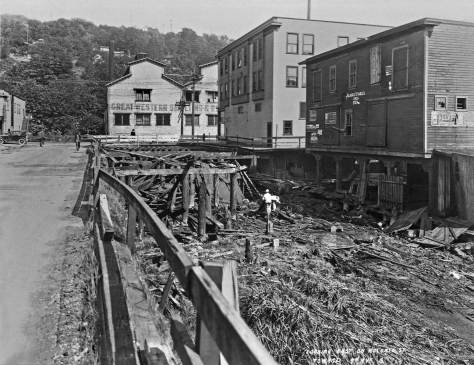(click to enlarge photos)


In 1904 when the Seattle Brewing and Malting Company had nearly completed the construction on their oversize plant in Georgetown, the citizens there, at least 300 of them brewery employees, voted to incorporate. The citizens took to politics largely to facilitate the sale of booze and associated pleasures – to create a town free of censors, prohibitionists, and all but the least acquisitive of tax collectors. The brewery’s superintendent, John Mueller, won two of the new town’s most important positions: mayor and fire chief. The third position, chief of police, was paid well.

Also in 1904, the brewery’s superintendent had a sincere talk with himself, the town’s mayor, about building, for the convenience of workers, a footbridge over the railroad tracks that separated the brewery from Beacon Hill, which is not so steep where it rises east of Georgetown. Although the footbridge was delayed for twenty years, the building of small workers’ homes to the east of the tracks was not. Many of these survive. On snuggly-fitted blocks 800 feet-long, upwards of thirty homes look at each other across streets, such as 16th and 17th Avenues South.


When new in 1904, the 855-foot-long red brick brewery along Duwamish Avenue (Airport Way) was a few feet longer than St. Peter’s Cathedral in the Vatican. It was billed by its boosters as the largest brewery west of the Mississippi, and by 1912, after some additions were made, including greater ice production and doubling the size of the bottling works, the Georgetown brewery was listed as the sixth largest in the world.


Locally, Georgetown’s “cathedral to brewing” was described as the largest industrial establishment in the state in 1914, the year that plans for the Juneau Street footbridge were revived. The brewery covered the cost, about $3,300. A C.H. Stratton won the contract on Dec. 10, 1914. Expecting to complete the construction in ninety days, he ran only a little late. As the caption across the base of the featured print at the top notes, “Juneau S. footbridge Built 1914-5, Open 3-26-1915,” which may be the date, or close to it, this print was recorded. A second caption at the bottom of the negative is too faded to include here. It reads, “Secured by efforts of Dept. of P.W.” (Public Works).

It was a different sort of “public works” that caused Georgetown’s growth and increasing optimism of the mid-teens to flounder. In 1916, the anti-saloon warriors and Washington State’s effective teetotaling legislators won the war against intoxicants by imposing statewide prohibition. Rainier Beer was moved to San Francisco. After midnight on Jan 1, 1916, bars were closed and all the jobs serving the imbibing culture – including those of hundreds of brewery and bar workers in Georgetown – were over. National prohibition, beginning in 1920, prevailed for thirteen often-farcical years of abstinence, until the breweries and bars were reopened in 1933. Months earlier, on Monday, Oct. 17, 1932, the deteriorating Juneau Street footbridge was closed to pedestrians and soon dismantled.

WEB EXTRAS
Anything to add, chief? Not as much as we ordinarily contribute. We will make up for it in about one month when our now-then on the Georgetown RR Station will be featured. It is a neighbor within yards of the pedestrian bridge. We will treat on both subjects – the trestle and the station – then in our video, which since late last year has introduced the blog. The truth is that Jean is also busy producing/directing another play with his students at Hillside School (in Bellevue – see the link for the school on our front page) and I am happy to give more time to wrapping up “Keep Clam,” my long work-in-progress on an Ivar Haglund bio. Meanwhile here on some neighborhood-related features, plus a few bridges, from the blog’s recent past, which Rod Edge has pulled and placed.












